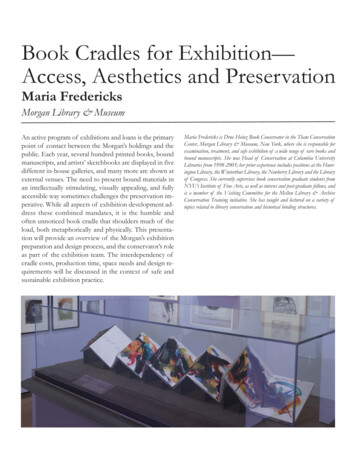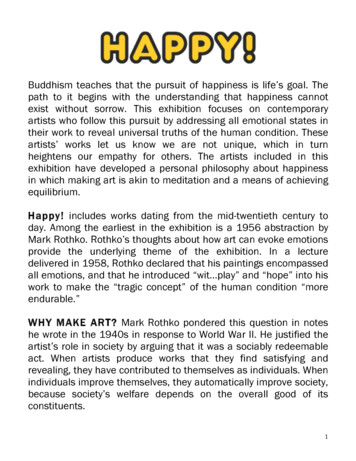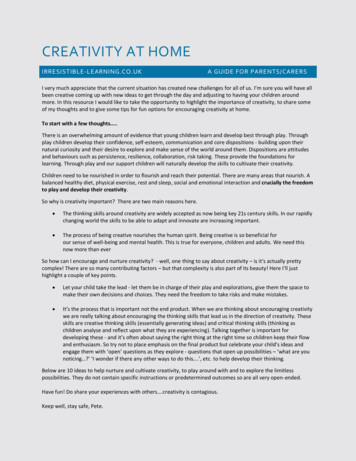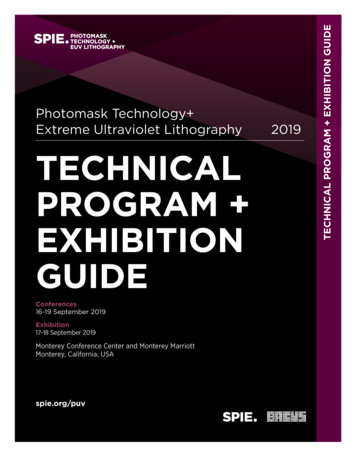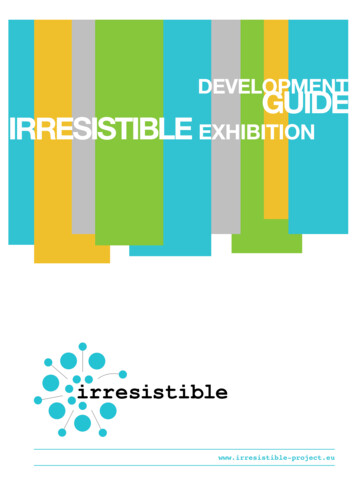
Transcription
A DEVELOPMENTGUIDEIRRESISTIBLE EXHIBITIONwww.irresistible-project.eu
IRRESISTIBLE EXHIBITIONS ! !A DEVELOPMENT GUIDE!!! During Work Package 3, groups ofteachers and students will be involved(and supported by the local Communityof Learners — CoL) in the developmentof exhibitions addressing the concept ofResponsible Research and Innovation.Through this process, teachers andstudents will understand that uncertaintyand risk are inherent to scientific andtechnological enterprises. So, researchand innovation must be driven byresponsibility. Teachers will also developtheir expertise on how to addressResponsible Research and Innovation(related to cutting edge scientific andtechnological issues) through theconstruction of exhibitions centred onsuch issues. These exhibits will take placein schools, universities, and sciencecentres or museums. This work packagecan be triggered, for example, by a visitto a science centre, a museum or anexploratory.!! Teachers and students wouldconsider not only the content of theexhibition but also its production values.The construction and presentation ofexhibits will function as a pretext and acontext to study the impact of thisprocess on teachers’ personal andprofessional development and studentscompetences.!!Each partner in charge of this workpackage will be responsible for findingthree teachers and three groups of theirstudents willing to participate in thisprocess. The partners, the scientists andthe science centre experts will beresponsible for following and supportingthe work of each group and studying theimpact of this process on teachers andstudents.! The idea is that the projectteam will produce a coherent set ofexhibits that will combine into atravelling exhibition, which can bedisplayed in the different countries inappropriate places like science centres.!! The different exhibitions should beinteractive and should approach differentaspects of Responsible Research andInnovation.Contents:The potential of studentplanned and designedexhibits about responsibleresearch and innovation2Interactive exhibitions4Interactivity scenarios forexhibits10General guidelines for allscenarios19References20IRRESISTIBLE exhibitions: a development guide1"
THE POTENTIAL OF STUDENTPLANNED AND DESIGNEDEXHIBITS ABOUTRESPONSIBLE RESEARCH ANDINNOVATION!! The construction of exhibits caninvoke inquiry-based approaches and theuse of narrative to address the conceptof Responsible Research and Innovation.In the process of either creating anexhibit or modifying an existing exhibit !Pupils devising and presenting anexhibition is a means of transformingscience from product to process(Hawkey, 2001). One of the advantages ofboth producing and presenting an exhibitis that it draws upon the facets of IBSE: inproducing an exhibition pupils can represent scientific facts as speculativequestions, transmissive teaching can betransformed, and the audience at theexhibit can construct their own learning.By presenting frontier knowledge or byusing an exhibit to raise questions theybecome learners with their visitors.Encouraging students to research theirown interests under the guidance of ateacher develops skills of formulatingquestions, collaboration and observation(Sleeper & Sterling, 2004). !the emphasis would be on elicitingpersonal reflection by those engaging inthe exhibit. Narratives can be createdfrom a multidisciplinary perspective. Indesigning an exhibit, or a narrative/inquiry focused dialogue to accompanyan exhibit, students would need toconsider how the exhibit gets theaudience thinking about issues ofResponsible Research and Innovation.!!! During these exhibits’ preparation,learners will ask questions, use logic andevidence in formulating and revisingscientific explanations, recognizing andanalysing alternative explanations, andcommunicate scientific arguments.!! Through the construction andpresentation of exhibits on ResponsibleResearch and Innovation both teachersand students are introduced to aIRRESISTIBLE exhibitions: a development guide2"
different type of science from the onethat is usually presented in scienceclasses. Most of the formal scienceeducation focuses on a conventional,non-controversial, established andreliable science. On the contrary, cuttingedge scientific and technological mattershighlight a “borderline science”, that iscontroversial, preliminary, uncertain andunder debate. The controversialdimension refers to “differences over thenature and content of the science such asthe perception of risk, interpretation ofempirical data and scientific theories, aswell as the social impact of science andtechnology” (Levinson, 2006, p. 1202).!! “Science is messy in application, oftenassociated with complexity, uncertaintyand controversy” (Jarman & McClune,2007, p. 122). So, students must be helpedto understand that relevant scienceknowledge may be considered asincomplete, uncertain and contested.Frequently, decision-making regardingscientific and technological mattersdepends on knowledge from differentdomains (not only from science andtechnology knowledge).!! The preparation of exhibits onResponsible Research and Innovationhelps learners to see that uncertaintyand risk are inherent in scientific andtechnological enterprises: howeverstrong the evidence for a theory, thereare always the possibilities of alternatives;that data on which evidence is based isnever certain but always has a degree oferror associated with it; that theinterpretation of data is influenced bymany factors including contemporaryknowledge and social context. Theproduction and presentation of exhibitscan involve students in inquiry anddiscussion. The discussion inherent to thepreparation of exhibits on ResponsibleResearch and Innovation can beparticularly useful both in terms oflearning about the contents, theprocesses and the nature of science andtechnology, and in terms of the students’cognitive, social, political, moral andethical development (Hammerich, 2000;Kolstø, 2001b; Millar, 1997; Sadler, 2004).!! Exhibitions about RRI, as a sociocultural context, can raise questions,elicit personal reflection and stimulateconversations between students andvisitors, transforming both of them intolearners (Braund & Reiss, 2004). !! The process of exhibits‘ constructionand presentation allows students tomove beyond analysis and discussion,creating an opportunity for them toparticipate in (and even to instigate)community action on socio-scientificcontroversial matters. Community actionis frequently considered a major aspectof scientific literacy (Hodson, 1998; Roth,2003).!IRRESISTIBLE exhibitions: a development guide3"
INTERACTIVE EXHIBITIONS!In the context of research incommunication there are severalcoexisting vision for the concept ofinteractivity — from the ones thatrestrict it to a communicative experiencemediated by technology, to the moreencompassing ones that include allcommunication forms, including somemediated. Also in the domain of researchin museums the notion of interactiveexhibitions is not consensual, resultingfrom the concept of interactivity beingused. However, according to Tost (2005)in the context of science centres andmuseums, interactivity seems, in general,to beclosely related with Information andCommunication Technologies (ICT), andtherefore is usually assumed astechnologically mediated phenomenon.!! Between the several existingdefinitions for the concept of interactiveexhibitions, one of the most consensualones is probably the one advanced byHill and Miles (1987) according to whomreal interactive exhibitions are thosewho change their presentation as afunction of the designer’s perception ofthe visitor’s response (Ree & Kim, 2013).In this definition, the participant’sresponse takes a crucial role, and mayeven take an effect on the exhibitionitself. Bitgood (1991) also definesinteractive exhibitions in a similarmanner, putting the emphasis on theuser’s ability to change the exhibitionsthrough his response to it. This authorrestricts his definition to the visitor’sphysical interaction with the artefacts,excluding mental interactions.!! In the context of an interactiveexhibition, the visitor his expect to attaina response from the exhibition throughhis actions on it (Bilda & Edmonds, 2008).Within this context, interactivity doesnot necessarily require a physical actionfrom the visitor since one can be activelyengaged in a process without any physicalinteraction. In this context, Wagensberg(2001), focusing on the interactionbetween subjects (visitors) and objectsthat takes place in science museumsdefined three levels of interactivity:manual or hands-on, mental or minds-on,and cultural or hearts-on. In the first, thevisitor is expected to manipulate models,objects or artefacts — and because ofthis physical manipulation, he may bebetter able to understand the workingsand the development of processes andnatural phenomenon. When genuine, thistype of interactivity allows a throughdialogue between the visitors and suchphenomenon, bringing him close to ascientist’s role. However, Wagensbergpoints out that this type of interactivityrequires much more than the simpletouch of a button. Mental interactivityallows the visitor to practice hisunderstanding of science, distinguishingthe wood from the trees whencomparing phenomena’s, and findingsimilarities between what may apparentlybe different. It expects that the visitor,taking the museum artefact as a startingpoint will be able to establish connectionwith his daily life, with other phenomenaand situations that may have similaressences and so develop hisunderstanding of the world. For Cheliniand Lopes (2008) exhibitions dealingwith controversial scientific issues mayeasily fit into this type of interactivity.Exhibitions where the dialogue betweendifferent perspectives is stimulated andthat challenge the visitor from both aIRRESISTIBLE exhibitions: a development guide4"
cognitive and an emotional standpoint,leading him into adopting a criticalstance.!! Even though science is universal, thereality where it takes place and developsis not, and for this reason it is importantto consider also the third type ofinteractivity — cultural or hearts-on. Forthis reason, exhibits should take intoaccount the collective identities presentand contextualizing the museum,stimulating the visitor’s recognition of thelocal community with the exhibit; andwhen the visitor is not local promotinghis awareness to a new culture. ForChelini and Lopes (2008), this is the typeof interactivity that is promoted, forexample, when a zoology museumchooses to build its exhibits based onlocal and traditional flora and/or fauna,promoting a local visitor’s sense ofidentity and raising a non-local visitorengagement and awareness to a newenvironment. According to these authors,the expression “glocal focus” mayillustrate this type of interactivity, since itadvocates the development of globalissues from a local perspective, and viceversa. This allow for the development offamiliar connections (from local toglobal) and the bridging towards moredistanced themes (from global to local)but also the value and identity of localcommunities.!! Referring to these three types ofinteractivity, Wagensberg comments thatthe ideal situation would be for theirsimultaneous presence. However, hedefines a gradient of importance wheremanual interactivity is seen as convenient,cultural interactivity as desirable, andmental interactivity as essential.!Interactivity With Interaction!The socio-cultural theory of learningemphasizes the idea that meaningemerges from the interaction betweenindividuals that act on social contextsand from the mediators present in suchcontexts. According to McLean (1999)the social interaction amongst thevisitors of an exhibit is, probably, one ofthe biggest contributions of museums forthe current day social dynamics. Themonitors present in the exhibits — aswell as others, such as actors andstorytellers — develop the context andencourage the visitors to interactamongst themselves and with theexhibition. In the absence of suchmediators, it is the responsibility of theartefacts themselves to develop thismediation, promoting the socialinteraction that supports the visitor’sunderstanding and knowledgedevelopment.!! Even though, in the museum context,the expression interactivity is stronglyanchored with the expression“interactive exhibition”, for Tsitoura(2010) the “interactive” adjective is onlya result of the use of ICT, ignoring mostof the time the social and emotionalaspects behind every museum exhibit —as a context – and interactivity — as aprocess. Exhibits have a tendency to becharacterized as interactive even whentheir interactive value is very limited. Thisapproach reveals a conception ofinteractivity that goes beyond the use ofICT. Tsitoura considers that interactivitymay even be present when museums donot label their exhibits as “interactive”.! The author criticizes the fact thatmany museums advertise their exhibitsas interactive (simply because they useIRRESISTIBLE exhibitions: a development guide5"
ICT), in a clear marketing campaign,relegating to a second level theireducational role as promoters of criticalthinking, crucial for the development ofboth individuals and society. Thesemuseums, by not conceptualizinginteractivity as a process, but only as aproduct of the use of ICT, are missing aprecious opportunity to contribute totruly engaging educational experiences.!! Research has been able to show thata visitors’ experience in a museum isgreatly influenced and shaped by thesocial interaction and dialogue developedbetween visitors (vom Lehn et al. 2001;Crowley, 2000; Leinhardt et al., 2002). Inaddition, it has been shown that learningand cognitive development are supportedwhen the participants engage in lastingactivities with artefacts, and when theyare engaged in social interactions anddiscussions with other participants(Heath, vom Lehm & Osborne, 2005).!! According to Hindmarsh, Heath, vomLehn and Cleverly (2005), mostinteractive exhibits adopt a very poorconcept of interactivity, related mostlywith the individual engagement of thevisitor with the exhibit/artefacts; andleaving the interaction between thevisitors as a lesser concern, orcompletely absent. In addition, the socalled multi-users exhibits, even thoughone could expect them to promoteinteraction between visitors, fail in thispurpose since they are planned topromote the simultaneous individualengagement of several users with thesame artefact, they are not collaboratingor interacting in any creative way — theyare only acting in tandem. For thesereasons, the authors recommend that itis crucial for museums to reconsidertheir concept of interaction whenplanning and developing exhibitions.!! Hindmarsh, Heath, vom Lehn andCleverly (2005) react to some studies! There are several studies illustratingidentifying a positive relationshiphow computers can be extremelybetween the use of interactive artefactsattractive to people, especially children,and the time spent by visitors, presentingand how they can facilitate socialthis relationship as possibly responsibleinteraction (Scrimshaw & Wegerif, 1997).for a more efficient learning given theHowever, it’s use in the context offact that the visitors are more effectivelymuseum exhibits, even though itengaged with the artefacts. These authorspromotes a longer time spent by thedeveloped studies on exhibits requiringvisitors (Serrem & Raphling, 1992) doesthe use of touchscreens, revealing thatnot seem to be effective for themost of the time spent by the visitorspromotion of social interaction (Flagg,was used to understand the functioning1994). Even so, more and more exhibitsof the artefact, instead of being used inusing computers are seen as a way forthe discovery and engagement with themuseums to effectively communicateeducative message being explored. Basedwith their audiences, as well as new wayson these studies, these authorsto promote participation anddeveloped some guidelines that shouldinteractivity, and so stimulate socialbe taken into account when developinginteraction and discussion among thean interactive exhibit that also aims toparticipants (Bradburne, 2000; Thomas &incorporate interaction between theMintz, 1998).!participants. With this goal they suggestIRRESISTIBLE exhibitions: a development guide6"
that opportunities should be createdallowing the visitors to established acontinued interaction and providingresources for them to model andcreatively reconfigure each other’sexperiences, for example, changing somedisplay aspects. !! This is in clear contrast with manyexhibits that follow a strict stimulusresponse model, where participants areexpected to perform an action (forexample pressing a button) that triggersan effect. On the contrary, Hindmarsh,Heath, vom Lehn and Cleverly (2005)encourage the design of exhibits that areeasy to transform and are collaborativelysupported leaving a trail of activity forfuture visitors.!! Tsitoura (2010) also considersimportant for museums to redefine theirconcept of interactivity and reflect aboutways to implement it that go beyondtraditional conceptualizations — that seeit only as a characteristic oftechnologically mediated communication,and established in a philosophy oftransmission as communication.According to Hooper-Greenhill (2000)the notion of communication associatedwith the concept of interactivity shouldnot be seen as transmission, but insteadas culture. The transmissive modeldescribes communication as a linearprocess where information istransferred/transmitted from anauthorative source to a non-informedreceptor. Knowledge is regarded asobjective, singular and without value. Themessage recipient is conceived as opento the proposed message. Which in turnis received more or less efficiently and inthe same manner by all participants.Thisreveals an extremely limited view ofcommunication sustained in technicalpractices and ignoring both social andcultural processes. On the other hand,the cultural model of communication isfocused on the way meaning isconstructed and supportscommunication as an integral part ofculture — as a set of negotiatedprocesses of meaning construction andpart of a complex and diverse culture.This model accepts the coexistence ofdifferent perspectives, often in conflict, ofhow the world can be explained.!! Therefore, and following thereasoning of Tsitoura (2010), museumsthat intend to promote interactivity froma non transmissive perspective, shouldmake an effort to become spaces ofdialogue that foster participation andinteraction among visitors.Communication is not inherentlyinteractive, or always developed from abidirectional perspective – unless theresponses are relevant and there isreciprocity for the messages exchangedbetween the participants. In themuseological context, the maincharacteristic for interactivity is thepromotion of opportunities for thevisitors to be actively engaged in themuseum spaces, and consequently havean effect on the exhibits. For Tsitoura(2010), more than discussing how topromote interactivity through thephysical characteristics of the artefacts,the most important thing is to discussthe ideological, social and historicalperspectives of what we want tocommunicate, and how we intend to doit. Moreover, we should consider how toactively engage citizens that are part of achanging society.!IRRESISTIBLE exhibitions: a development guide7"
! Therefore, the active participation ofvisitors/leaners is a keystone to foster aneffective learning environment, withdialogue being the key to promoteparticipation – allowing the participantsto raise hypothesis, argue, and challengeothers, developing arguments thatsupport their conceptual understandingand justify their points of view (Heath,von Lehm and Osborne, 2005). Withother participants doing the same, thiswill fuel the emergence of a more clearconceptual understanding, with theknowledge developing as a coconstruction of the group. In this context,social interaction is a key requisite forthis construction to take place. Thecapacity for an exhibit to foster this kindof environment is a direct measure of itsdegree of effectiveness. In this way, itbecomes fundamental for museums toput social interaction in the centre oftheir agenda. Otherwise, they will keepon experiencing the frustration of havingvisitors using their interactive artefacts inunexpected ways, and be faced withdisappointment with their conducts,experiences and learning assessments.!!IRRESISTIBLE exhibitions: a development guide8"
!Interactive artefacts:What characteristics?In the context of multimedia artefactsdeveloped to support Learning,interactivity can and should be morethan allowing the user to choose his ownpath in an application, only by “point andclick” through a bunch of buttons andmenus (Cairncross & Mannion, 2001). Ifwe aim to foster deeper learning, thenthe applications should actively engagethe user, challenging him with tasks toaccomplish – allowing for the applicationof the new knowledge being presented/introduced. It also important to stimulatethe reflection about the experiences thatare carried out.!! Several authors have dedicatedthemselves to studying how canmultimedia applications stimulate realinteractivity and so foster the users’deeper learning (Caincross & Mannion,1999; Rogers & Scaife, 1997). Aldrich,Rogers and Scaife (1998) consider that itis fundamental to design Learningactivities that cognitively engage the user,leading him to reflect about the materialbeing presented, its meaning, relevance,and how it can be applied in a variety ofcontexts.!! There are several ways for the userto interact with multimedia artefacts:manipulating virtual objects on a screen,or different variables when simulatingexperiences or industrial processes. Thisallows them to safely experiment andanalyse the consequences of choosingeither a correct or an incorrect path,promoting a deeper understanding of agiven subject. Users may even haveaccess to alternative paths that may havepositive or negative consequences.Interactivity is also closely related torole-playing, allowing the user to takeinto account a variety of perspectives.There may also be immediateassessments, with immediate feedback:the results may be stored allowingdevelopers and users to monitorprogress.!! Interactivity can also be used in thecontext of synchronous andasynchronous communication betweengroups of learners’ through the use ofemail, discussion forums andvideoconferencing. This stimulates theusers to apply the new knowledge beingintroduced in the context of a discussionwith others, while at the same time facinghim with alternative interpretations,helping to clarify any miss conceptions.This process of dialogue encouragesreflexive thinking and promotesreconceptualization, leading to a deeperknowledge and understanding of thelearning materials (Mayes, 1995). ForMcKendree et al. (1997), learning can bestimulated when the users/learners canhave access to the discussions ofprevious groups who studied the sametopics.!! Allowing the learner to stop andreflect about the material that he isvisualizing is very important, and can beaccomplished through the inclusion ofself-assessment questions. Interactivitymay also be used to learners engagementwith the activity, and therefore is learning,through the use of virtual questionnairesthat allow him to test and apply hisknowledge.!IRRESISTIBLE exhibitions: a development guide9"
INTERACTIVITY SCENARIOSFOR EXHIBITS !! Next, we will present a set ofinteractivity scenarios sustained by aconcept of interactivity that goes beyondphysical interactivity with the artefacts,to require a mental or minds-oninteractivity, accomplished through thecharacteristics of the artefacts promotingthe mental engagement of the visitorwith the exhibit. This perspective is alsosustained by a conception of interactivitythat privileges the interaction betweenvisitors and with the artefact designers.Even though it may be mediated bytechnologies, we consider thatinteractivity may be present even whentechnologies are not; or that if present, itmay not be the most important facet ofthe artefact.!! For all the presented scenarios it iscrucial to develop the conditions for thevisitors to conduct the activities —required by the artefacts — in aninterdependent mode, requiring them tocollaborate, discuss, and share ideas andarguments. Another commoncharacteristic is the opportunity forvisitors to leave their mark in the exhibit— as a comment (for example in aposter) or by changing the configurationof some of the elements in the artefacts/exhibit. It is also important that all ofthem, by the end of the exhibit, answer aquestionnaire (online or in paper) aboutthe impact of the exhibit in theirunderstanding of the topics and aboutthe possibility that it may have effectivelymade aware to change their behaviours.This will be important for the exhibitdesigners (students) to have access tothe visitors’ opinions and so assess theirwork.!"SCENARIO 1POSTER! The poster may explain the researchdesign used by the students throughouttheir project — including text andimages. As a matter of fact, any scientisthas, as one of his priorities, to make theresults of his work available for a largerscientific community. The visualpresentation of the results as a poster isone of the possibilities to accomplish thistask. Posters, being majorly static graphicpresentations, allow for careful readingand understanding of their contents.Moreover, if the author is present, theyfacilitate direct contact and fosterinteresting discussions.!! A poster should be considered apurely visual communication mode,meaning that it is an illustrated summarynot requiring any spoken explanation.But, it will only fully accomplish its goal ifit can attract and fixate the naturalcuriosity of a passer-by — being visuallyappealing. !!OPTION 1Physical poster! There are some recommendations totake into account when planning andchoosing the materials for a poster —that will globally improve its ability tocapture and retain the observers’attention.!! The best way to plan this work isthrough a simulation; it is important touse a workbench or table top with theIRRESISTIBLE exhibitions: a development guide1" 0
required measurements, or use a piece ofpaper with the dimensions of the finalposter, where all the elements that aregoing to used can be included in order tostudy the interaction and dynamicsbetween them.!! On the poster’s structure, it shouldbe taken into consideration that thetitles and subtitles play a defining role onits ability to capture the audience’spassive attention. The choice of words isalso of extreme importance, andpreference should be given to small,simple, and evocative sentences. Besidesthe title and names of the authors andinstitutions that introduce the poster, it iscommon to divide the remaininginformation into basic units or sections— introduction, main topics (materials,methods and results), and conclusions.Both the introductions and conclusionsshould be short, and structured in a lightand stimulating reading style, since theyare the observer’s immediate readingtargets. Only after that, and if the topicraised is curiosity, will the observer readthe poster with greater attention.!! The main section should be writtenin a simple and concise mode, using shortsentences. The exclusive use of capitalletters should be avoided since theyoccupy 40-45% more space and lowercase and reduce the reading speed.Bibliographical references should beavoided since a poster’s dynamic iscompletely different from a scientificpaper or book.!! The text section and visual elementsshould be placed on the supportingbackground occupying similar areas inorder to compose a balanced set. Theuse of colour can greatly help theposters dynamic, highlighting the mainsections over the less important ones. Ingeneral, it is recommended to use warm,clear, and appealing colours, for thebackgrounds, and more saturated coloursfor the frames, lines and arrows. If thegoal is to establish a duality betweencolours, it is convenient to usecontrasting choices — but not toaberrant the use of textured supportsurfaces or the creation of threedimensional elements — using, example,cardboard or Styrofoam — alsocontributes for the same goals. !! The text is also an integral part of theposter: considering that it is going to beread from at least a one meter distance,it is important to carefully consider thechoice of font styles and sizes. A lessfortunate choice will make the posterhard to read and tiring for the observers.For these reasons, it is recommended touse our choice should rest on fonts withfew curves such as Helvetic or TimesNew Roman, preferably bold. As afunction of the font size it is thenimportant to establish a hierarchy ofvalues for the text: the title should becomposed by the larger capital lettersand dimensions (4-5 cm) capable ofcapturing an observer’s attention from a5 meter distance. The names of theauthors and institutions may be writtenin a smaller size than the one use for thesubtitles — capital letters with adimension of 2,5 to 3,0 centimetre.Overall the entire title, authors andinstitutions set should not account formore than 18 cm in height. The main textshould be in lower case font withdimensions between 0,8 and 1,0centimetre.!! Figures are the most appealingfeature on a poster, and, therefore, shouldIRRESISTIBLE exhibitions: a development guide1" 1
be carefully considered and planed for. Inorder be readable from 1,0-1,5 meters,illustrations should be designed withthick lines and have sufficient contrast —such as tables, graphs and diagrams.When necessary, the scale should not beforgotten, and captions should bepreferably presented horizontally. It isrecommended to avoid too muchuniformity, creating a diversity of visualelements with a variety of dimensions;the amplification that they may besubjected to should not be more thanthe dimension of an A4 sheet (21,0 x29,7 cm).
IRRESISTIBLE EXHIBITIONS ! A DEVELOPMENT GUIDE!! During Work Package 3, groups of teachers and students will be involved (and supported by the local Community of Learners — CoL) in the development of exhibitions addressing the concept of Responsible Research and Innovation. Through this process, teachers and

